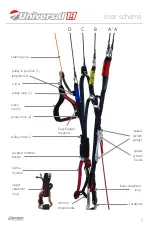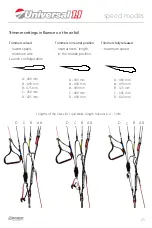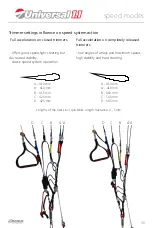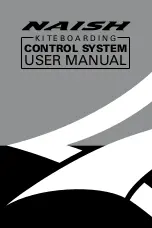
The combined technique (weight shifting and brake input) is by far
the most efficient method of turning. Turn radius is then determined
by the amount of inside brake used and weight shift. Additional
application a little outside brake after initiating the turn with
maximum weight shift increases turn efficiency and the outboard
wing’s resistance to collapse (in turbulence, the edge of a thermal
etc).
In case of necessary turning in confined area at slow speed (e.g.
slope soaring), it is recommended to steer the decelerated canopy
by loosening the brake at the outside of the turn while applying just
a little more brake on the inside.
Caution:
when entering a turbulent area you should brake
a little to put up the tension. It will allow you to react
instantly in case of a problem. Too hard or too quick pulling
of one brake can cause the wing to enter a spin.
Thermalling and soaring
When flying the Universal 1.1 minimum sink is reached with slight
brake pressure applied (10 to 15 cm, depending on pilot’s weight).
In turbulent conditions the canopy should be flown with a small
amount of brake applied. This improves overall stability by
increasing the angle of attack of the canopy. The canopy should
neither rock back nor surge forwards, but always stay above the
pilot. In order to achieve it, the pilot should accelerate the canopy
by letting off the brakes when entering a thermal (according to its
strength) and brake it on exiting. This is part of basic active flying
that can spare you many potential collapses.
When soaring the slope, minimum height of 50 m above the
ground is recommended for safety reasons. It is important to
comply with air traffic rules, especially when many pilots share
airspace close to the hill.
The avoidance manoeuvres often happen to be impossible in such
conditions.
Trimmers and speed-system operation
When flying into head wind or through sink it is advisable (for the
sake of best glide angle) to increase speed, as long as conditions
are not too turbulent.
Full application of the speed system increases flight speed by some
30%. In contrast to most paragliders it does not decrease wing
stability significant, but if you meet some serious trouble, it is
advisable to release the speedbar. The faster you fly, the more
dynamic colapses can happen. With application of the speed
17
free flight - flight
!
Содержание Universal 1.1 23
Страница 1: ...user manual V 07 07 2018 BASIC risers ...
Страница 12: ...How to match the pulley level and steering line mark with the suspension height before first use 12 ...
Страница 46: ...46 rigging scheme ...
Страница 48: ...Dudek Paragliders ul Centralna 2U 86 031 Osielsko Poland tel 48 52 324 17 40 www dudek eu info dudek eu ...
















































